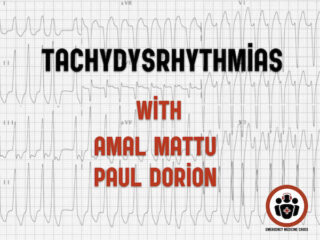Resuscitation
Ep 112 Tachydysrhythmias with Amal Mattu and Paul Dorian
In this EM Cases main Episode 112 Tachydysrhythmias with Amal Mattu and Paul Dorion we discuss a potpurri of clinical goodies for the recognition and management of both wide and narrow complex tachydysrhythmias and answer questions such as: Which patients with stable Ventricular Tachycardia (VT) require immediate electrical cardioversion, chemical cardioversion or no cardioversion at all? Are there any algorithms that can reliably distinguish VT from SVT with aberrancy? What is the "verapamil death test"? While procainamide may be the first line medication for stable VT based on the PROCAMIO study, what are the indications for IV amiodarone for VT? How should we best manage patients with VT who have an ICD? How can the Bix Rule help distinguish Atrial Flutter from SVT? What is the preferred medication for conversion of SVT to sinus rhythm, Adenosine or Calcium Channel Blockers (CCBs)? Why is amiodarone contraindicated in patients with WPW associated with atrial fibrillation? What are the important differences in the approach and treatment of atrial fibrillation vs. atrial flutter? How can we safely curb the high bounce-back rate of patients with atrial fibrillation who present to the ED? and many more...
BCE 73 Esmolol in Refractory Ventricular Fibrillation
In anticipation of EM Cases Episode 112 on Tachydysrhthmias with Amal Mattu and Paul Dorion, Melanie Baimel tells her Best Case Ever of a previously healthy young man who presents in refractory ventricular fibrillation after receiving multiple single shocks, ongoing chest compressions, several rounds of epinephrine, amiodarone and dual sequence defibrillation without ROSC...
CritCases 10 Hyponatremia Associated Seizures
In this EM Cases CritCases blog - a collaboration between STARS Air Ambulance Service, Mike Betzner and EM Cases, a middle aged woman presents to a rural ED with headache and vomiting, normal vital signs with subsequent status epilepticus and serum sodium of 110 mmol/L. What management recommendations would you make to the rural ED physician, the transport team and in your ED with regards to treatment of seizures, safe correction of hyponatremia, airway management, search for underlying cause and prevention of Osmotic Demyelenation Syndrome?
Ep 110 Airway Pitfalls – Live from EMU 2018
The last decade has seen a torrent of literature and expert opinion on emergency airway management. It is challenging to integrate all this new information into a seamless flow when faced with a challenging airway situation. In this live podcast recorded at North York General's Emergency Medicine Update Conference 2018, Scott Weingart and Anton Helman put together the latest in emergency airway management by outlining 6 common airway pitfalls: Failure to prepare for failure, failure to position the patient properly, failure to optimize oxygenation, failure to optimize hemodynamics, failure to consider an awake intubation and failure to prepare for a cricothyrotomy...
BCE 71 Cricothyrotomy and the Value of Simulation Training
In anticipation of EM Cases Episode 110 Airway Pitfalls Live from EMU 2018 with Scott Weingart, we have Dr. Shira Brown tell her Best Case Ever of a pediatric trauma patient who required a cricothyrotomy. She explains how, despite working in a non-trauma center with limited resources, her team was well prepared because of the robust simulation program specifically designed for practicing emergency physicians that she had developed in her region. We also discuss the advantages and disadvantages of the scalpel-Bougie vs scalpel-finger-Bougie cricothyrotomy techniques and to maintain an optimistic attitude in seemingly futile cases...
BCE 66 CHD with Bronchiolitis: A Delicate Balance
When patients with known congenital heart disease present to the ED with common illnesses we need to consider how their physiology might alter our approach to those common illnesses. Max Ben-Yakov guides us through his Best Case Ever of a CHD patient who presents with bronchiolitis and gives us some tips on how best to approach these fragile patients in a crisis situation...







